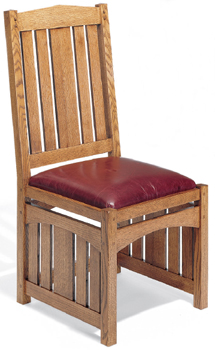
I am attempting to make my first real chair. I am an intermediate-skilled woodworker and have made benches and other sitting furniture, but they were not very chair-like since they all had square joinery. I am much more comfortable and experienced in making joints that meet at 90 degrees or are only angled in one plane and not at a compound angle. How important is it to the stability of a chair structure that the legs be canted back and angled to the seat frame? Is a taper on a straight leg as good as canting it? It is readily apparent that a structure with splayed legs is less prone to tip over than one with perpendicular legs; however, I still see commercially available chairs and even bar stools that have four perpendicular legs (especially metal ones). To what degree is the chair less stable, or less prone to joint stress, because of the splay and cant of the legs as compared to one with vertical and square legs? — Spencer Ferdinand
Tim Inman: Good on you for wanting to make a chair! Get right in there and make one. Use scrap and make it quick. I think the practice mock-up effort will really repay you on the “real thing.” Getting those joints right will not be as tough as you’re thinking. So, to get over the fear of flying, get some cheap, easy lumber and crack out a chair for practice. The real reasons to make a chair, in my view, are comfort and a sense of accomplishment. Getting the angles “right” (correct) makes for the most comfortable chair. Squared-off legs at right angles may be easier, or in vogue at the present, but they’re not very comfortable. Good angles feel right, and you want to sit in the chair. Go for that. Once you’ve banged out a sample to prove to yourself how to do it (and you will!), then make a really pretty chair. The time spent practicing will be repaid on the final project. Difference is, though you won’t spend much more total time, the second chair will be so superior to the first one. If you just make one, then all your mistakes and trial-and-error work will show in the final product. Make two, and burn the first one. Be prepared to be envied.
Chris Marshall: I’ll take a different approach from Tim’s answer by admitting my own limitation: I’ve never built chairs. If I were going to dive into a chair project, wood costing what it does these days, I’d be inclined to find a good set of plans for a classic chair style and start there. In other words, I’d go for what works and learn from a proven design. Not that I’m criticizing experimentation in the least, and if you go that route, by all means do your prototyping, just as Tim suggests! All I’m suggesting is that we can learn from the efforts of others, particularly when it comes to projects that must satisfy ergonomics, engineering and style. A chair’s “success” certainly depends on all three factors.





